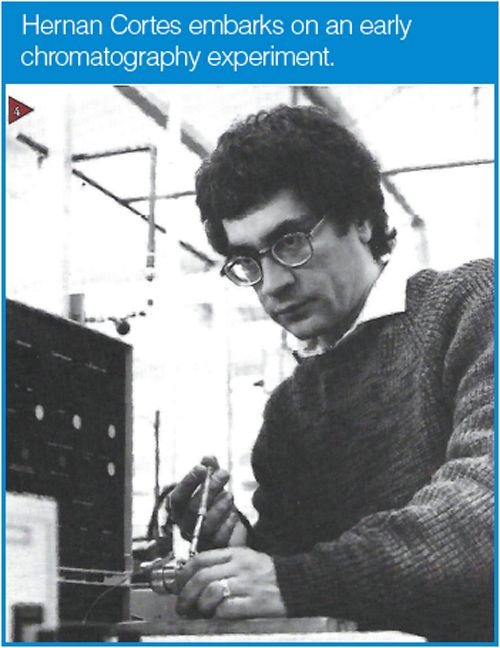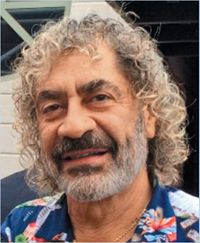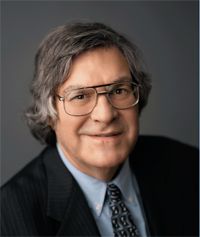Hernan Cortes
Mark Schure spoke to LCGC Europe’s Lifetime Achievement Award winner, Hernan Cortes, about his career with Dow Chemical, multidimensional chromatography, the evolution of mass spectrometry (MS), and the direction that liquid chromatography (LC) is taking.
Mark Schure spoke to LCGC Europe’s Lifetime Achievement Award winner, Hernan Cortes, about his career with Dow Chemical, multidimensional chromatography, the evolution of mass spectrometry (MS), and the direction that liquid chromatography (LC) is taking.
Mark Schure: When did you first learn about chromatography and when did you first get involved in practice?
Hernan Cortes: I know it’s a cliché but my parents bought me a chemistry set at an early age. I am a fortunate individual in that I found my calling early in life. I became interested in chromatography in the organic chemistry laboratory, where we essentially reproduced Tswett’s gravity column experiment, and it intrigued me. My first assignment at Dow was in size-exclusion chromatography (SEC), followed by gas chromatography (GC) and liquid chromatography (LC).
MS: What brought you to Dow Chemical?
HC: While studying for my BS degree in chemistry at the Florida International University in Miami, USA, Dow was recruiting for a summer internship. I was offered an opportunity, and, after completing the assignment, was offered a permanent position. I proposed to my wife, Sandra, at the same time and suggested we could move to Michigan, spend a couple of years with Dow because it would look good on the CV, and then find a job somewhere warm. As it turned out, I had a wonderful, fulfilling career and we have been in Michigan for 38 years!
The company was at the time very supportive of research and encouraged analytical personnel to find an area of study and provided the resources needed. It was understood that research efforts, although encouraged, would take place in addition to fulfilling the requirements of the current job so one had to invest personal time to accomplish this. Dow at the time was well known for chromatography development, with inventions such as gel permeation chromatography (GPC) leading to the formation of Waters Corp. and ion chromatography (IC) leading to the formation of Dionex. Interest in hydrodynamic chromatography (HDC), indirect photometric chromatography (IPC), high performance liquid chromatography (HPLC), and capillary GC made it a fertile environment. It helped that the corporation considered analytical chemistry a competitive advantage and invested in its growth. It should not be a surprise why the “couple of years” proposition mentioned above was not fulfilled.
MS: What is it about chromatography and separations that you find interesting and challenging?
HC: The fundamentals are as complex as any other analytical branch, but the ease of use makes the technology the most widely used analytical tool. One doesn’t need fundamental knowledge to operate a chromatographic instrument, but without it it’s difficult to be creative, so for me it offered practical applications with the ability to delve into the fundamentals. It’s also interesting to continue to hear that chromatography has reached a plateau. If I look at a current GC instrument, and compare it to the first GC I ever used, multiple developments are present that, although incremental, make today’s instrumentation much more powerful. In LC we can see the same. We are approaching theoretical limits in one dimension, with better instrumentation, sub-2-μm packings, and core–shell particles. Multidimensional chromatography continues to grow and evolve, offering significant opportunities for problem-solving and knowledge generation.
MS: Why do you think that publishing is necessary as a scientist who has worked mostly in industry?
HC: Documentation is part of the scientific method, and as such it is important to publish scientific results. In industry, much of the information generated is considered proprietary, therefore is not suitable for external publication in peer-reviewed journals. However, there are many opportunities to publish technology-based papers without revealing intellectual property as long as this activity is supported. A scientist in industry can have a successful fulfilling career without publishing in peer-reviewed literature, because in industry the value provided is determined in a shorter term and is measurable. This is in contrast to academia, where “publish or perish” is an ancient but true statement. Perhaps this is why industry scientists, with very few exceptions, are not as widely recognized as academics in our field. In my case, I have found great satisfaction in publishing and sharing information for the scientific community to benefit, which is part of our responsibility as scientists. There are many ways to teach and this is a good medium for doing so. I feel I have been able to make contributions to the field as well as learn from it. Publishing also led to the opportunity to complete my studies and to receive my Ph.D. from Stockholm University, Sweden, with Prof. Bjorn Josefsson. The company was very supportive of this effort and provided the resources to accomplish this, albeit once again using a lot of personal time.
MS: Why did you publish your book on multidimensional chromatography? It seemed so ahead of its time on reflection (1).
HC: I had written a chapter for Frank Yang’s book on Microcolumn Separations (2), mainly relating to LC×GC using microcolumns in the first dimension, and was approached by Marcel Dekker regarding editing a book. Since there was not a single book at the time collecting current information about multidimensional chromatography, it seemed like a good opportunity to contribute and collect the relevant information in one volume. I wrote two chapters and I was fortunate to have fantastic chapter contributors. I was honoured that Prof. Giddings agreed to write the introductory chapter, which colleagues have told me is a “must read” in the field. I strived to cover as many aspects of multidimensional chromatography as were known at that time. Looking back, I don’t know what possessed me to undertake that project, because it was largely done during personal time. However, I am happy I did it because it was, for a time, a unique resource.
MS: What are the issues still present in the evolution of two-dimensional chromatography?
HC: The field has evolved significantly since the publication of our book (1). The advent of the comprehensive approach has yielded a wealth of information for very complex matrices analyzed both in the gas and liquid phase. Having said that, I believe multidimensional chromatography, where we are interested in only a region of the first dimension separation as opposed to the total as in the comprehensive approach, still has a lot of power for problem solving and is perhaps under-utilized. We can generate gorgeous contour plots, but the need remains for data interpretation and deciding what to do with so much information. Further efforts in quantitation and data mining are still needed. We still have unutilized separation space in the comprehensive approach. In regards to applications, there are and will continue to be many. Continuing to reduce the analysis time and instrument costs will offer increased acceptance by the chromatographic user community.
MS: You practised supercritical fluid chromatography (SFC) in a time when it was still looking for problems to solve. What is your present view on SFC and do you think it will be accepted this time around?
HC: Our experience with SFC was in the early stages, when the technology was practised in capillary columns more akin to GC than LC. Unified chromatography was thought to be possible with these expanded operating conditions. From a research point of view, we were fortunate to have Prof. Milton Lee as a consultant at Dow during that time, and we were able to develop a number of applications as well as the use of silica structures now known as monoliths as frits for microcolumn LC and as multipath decompression devices for SFC, to reduce the problems with single-point restrictors.
From a practical point of view, SFC was thought (as with any emerging technology) to be applicable to a larger number of applications than was actually the case. The reality is that SFC was applicable to perhaps 5% of the systems we studied. Thus it became a niche technology.
The current approach to SFC is more akin to LC and can better incorporate the use of modifiers to expand the technology’s utility. Will it replace LC or GC? I don’t believe so. This does not mean there isn’t great value when used judiciously. Another driving force today is a question of costs and environmental concerns (solvents). SFC used carbon dioxide primarily, which is less expensive than conventional LC solvents, and has less issues with toxicity and disposal. I have always considered SFC complementary to LC and GC rather than competitive, and we used it where it was most appropriate.
MS: Regarding training a new generation of chromatographers, will the use of mass spectrometry (MS) dominate the analytical chromatographer and be thought of as another column?
HC: Chromatographers thought of MS as detectors for the separation, while MS practitioners thought of chromatography as a sample introduction system for their MS. Today, chromatographers understand MS as more than just detection, with developing skills in interpretation and database usage, and spectroscopists practise chromatography development as an integral part of the analytical system. I believe the techniques are merging. In fact, future generations of chromatographers will use MS more as a separation dimension. Chromatography also suffers from the fact that it is easy to perform for someone without fundamental understanding of the process. A practitioner can inject a sample into a chromatograph and produce data without having an understanding of the fundamental process. Peaks can be quantitated with standards, etc. In MS, a practitioner without knowledge of fragmentation and organic chemistry, can search databases and come up with proposed structures. However, this is dangerous because databases can be misleading. From the perspective of productivity, younger scientists will probably place more effort on the MS side, which may lead to less focus on chromatography development. The debate concerning deconvolution versus separation will always exist, fortunately. This is a personal opinion. Some practitioners have believed that eventually separations will not be necessary because deconvolution models could yield the information needed I don’t believe progress in deconvolution models have yet or will make separation obsolete in my lifetime. But the efforts are very important to future understanding and growth. By more fully utilizing MS information with advanced software, it is statistically possible to defuse peaks that single channel detectors would miss entirely. With regards to dimensionality, MS offers that degree particularly in information content and will be seen this way more commonly in the future.

MS: Do you think industry regards the analytical chemist as a problem solver?
HC: During my tenure at Dow, analytical chemists were always considered an integral part of the development and problem-solving teams. If one cannot measure well, how can one understand and solve a problem? Having said that, a large portion of an analytical chemist’s efforts revolves around data generation. Translating this data into new information and knowledge should be an important part of the analyst’s responsibilities, and requires knowledge of chemistry, be it organic, polymer, bio, catalysis, etc. My experience consulting with small venture capital companies after retiring from Dow indicate that analytical science is valued and necessary for success. Since I have been retired for seven years, I cannot offer an opinion on how large corporations view this issue today.
MS: Do you think liquid chromatography needs smaller particles and higher pressures or do you think the technology is near the end of development?
HC: LC has certainly evolved from the time I first started in the field. Particle sizes of 10 μm were the norm, and I remember drawing baselines by hand and measuring peak heights from strip chart recorders! Today we are approaching theoretical limits, software is incredibly sophisticated, and injection and detection systems have been optimized. I believe further development will continue, in the direction of stationary phase design, miniaturization, and portability. With regards to further particle size reduction and operation at even higher pressures, I am not convinced the effort necessary to operate at particle sizes of 1 μm or less is the most productive approach. I have an interest in using temperature for improving resolution and we developed low thermal mass LC to allow the use of linear and oscillating temperature gradients; we have also used temperature pulses to facilitate the separation of unresolved components (5). I believe temperature is the “orphan” variable in LC and is underutilized. As a result of thermal mass limitations, we conducted our research in this area with packed fused silica microcolumns. This is a limitation because many practitioners want to use conventional size, off-the-shelf columns. I believe there are opportunities in this area that may be worthwhile pursuing rather than concentrating on further particle size reduction. Having said that, there are temperature limitations to some of the current media that require further research and development.
From a different perspective, when column efficiency or selectivity were not sufficient to separate components of interest, I turned to multidimensional chromatography, focusing on selectivity differences as an easier way to obtain required resolution rather than longer, smaller particle columns to increase efficiency.
MS: For chromatographic sciences what are the best conferences to attend?
HC: This is dependent on one’s interests. Certainly the HPLC meeting and the ISCC meeting are very productive and the most attended in the separations field. Pittcon is another one, broader in scope but very useful especially for younger practitioners every few years. Some of the more specialized conferences such as HTC and GC×GC are also very useful; there is value in concentrating more specialized technologies in one conference. For me, ISCC holds a special place, because the 6th edition was the first conference I attended where I had a presentation. I was particularly thrilled to meet in person a number of separation scientists whose work I admired and knew only from the literature, such as Profs. Novotny, Giddings, Ishii, Sandra, Cramers, and many others. It was particularly gratifying to have professors visit your poster and discuss science at leisure. This was also my first publication in multidimensional chromatography, using LC×GC. That experience taught me the value of interacting in the global separations community. Those were great learning experiences and a strong motivator for furthering efforts in my research, publishing and presenting my results. HTC is also special for me, and I am honoured to have worked with my friends Dr. Robert Smits and Dr. Rudy Senten in the Organizing and Scientific committees of this symposium.
MS: Do you have any advice for separation scientists at the beginning of their careers?
HC: Yes. I have a number of thoughts on this that I figured out over the years. First, you must never stop learning and teaching. This is important because it keeps you questioning some of the basics about the science and makes you listen to yourself and others. Next, there is no “normal” path to a career. It is highly influenced by the projects and people who surround you. “Normal” is a setting on a washing machine or dryer. I have also found that there are essentially three ingredients to a successful career: intelligence, hard work, and luck. For most situations, two out of three don’t make it. Finally, I have found that practising good time management is a skill that develops over time but is absolutely critical for success; time is the only commodity you can never get back.
References
H.J. Cortes, Ed., Multidimensional Chromatography Techniques and Applications (Marcel Dekker, N.Y., USA, 1990).
H.J. Cortes, in Microbore Column Chromatography, F. Yang, Ed. (Marcel Dekker N.Y., USA, 1988), p. 212.
H.J. Cortes and I. L. Davies, LC/GC, 3, 276 (1989).
M. Pursch, A. Schweizer-Theobaldt, H. Cortes, H. Schulenberg, A. Gratzfeld, and B. Hoffmann, LCGC Europe21, 152–159 (2008).
B. Gu, H.J. Cortes, J. Luong, M. Pursch, P. Eckerle, and R. Mustacich, Anal. Chem.81, 1488–1495 (2009).

Hernan J. Cortes joined Dow in Midland, Michigan, USA, in 1978 as an analytical chemist and held a number of positions in various analytical sciences groups including polymer characterization, inorganic analysis, organic analysis, agricultural chemicals, and pharmaceuticals, eventually becoming technical leader for the global organization. Hernan’s technology expertise lies in separation science, with an emphasis on gas, liquid, supercritical, and multidimensional chromatography development.
He retired from Dow in 2009 and formed Hernan J. Cortes Consulting, LLC., providing services in separation science. He is an Adjunct Professor at the University of Tasmania, Hobart, Australia. He is currently performing research with Michigan State University, USA and the University of Messina, Italy.
Hernan is the author of over 80 external publications in peer-reviewed journals, 17 patents, and editor of the first ever book on the subject of Multidimensional Chromatography (3,4).
Hernan holds a B.S. in chemistry from Florida International University, Miami, USA, and a Ph.D. in analytical chemistry from the University of Stockholm, Sweden.

Mark R. Schure is Chief Technology Officer of Kroungold Analytical, a consulting company he founded in 2012. He received his B.S. from Northeastern University, his Ph.D. from Colorado State University, and performed his postdoctoral study at the University of Utah. He joined the science group at Digital Equipment Corporation in 1984 and performed research at the Rohm and Haas Company for 23 years in computational, physical, and analytical chemistry research.
He has been Adjunct Professor of Chemical Engineering at the University of Delaware since 1995. His contributions to separation science include performing detailed theory, simulations, and experimental investigations in liquid chromatography (LC), capillary electrophoresis (CE), and field-flow fractionation (FFF). He has published over 100 papers, one book on two-dimensional (2D) chromatography, and has presented numerous short courses on 2D chromatography.


New TRC Facility Accelerates Innovation and Delivery
April 25th 2025We’ve expanded our capabilities with a state-of-the-art, 200,000 sq ft TRC facility in Toronto, completed in 2024 and staffed by over 100 PhD- and MSc-level scientists. This investment enables the development of more innovative compounds, a broader catalogue and custom offering, and streamlined operations for faster delivery. • Our extensive range of over 100,000 high-quality research chemicals—including APIs, metabolites, and impurities in both native and stable isotope-labelled forms—provides essential tools for uncovering molecular disease mechanisms and exploring new opportunities for therapeutic intervention.
New Guide: Characterising Impurity Standards – What Defines “Good Enough?”
April 25th 2025Impurity reference standards (IRSs) are essential for accurately identifying and quantifying impurities in pharmaceutical development and manufacturing. Yet, with limited regulatory guidance on how much characterisation is truly required for different applications, selecting the right standard can be challenging. To help, LGC has developed a new interactive multimedia guide, packed with expert insights to support your decision-making and give you greater confidence when choosing the right IRS for your specific needs.

.png&w=3840&q=75)

.png&w=3840&q=75)



.png&w=3840&q=75)



.png&w=3840&q=75)











